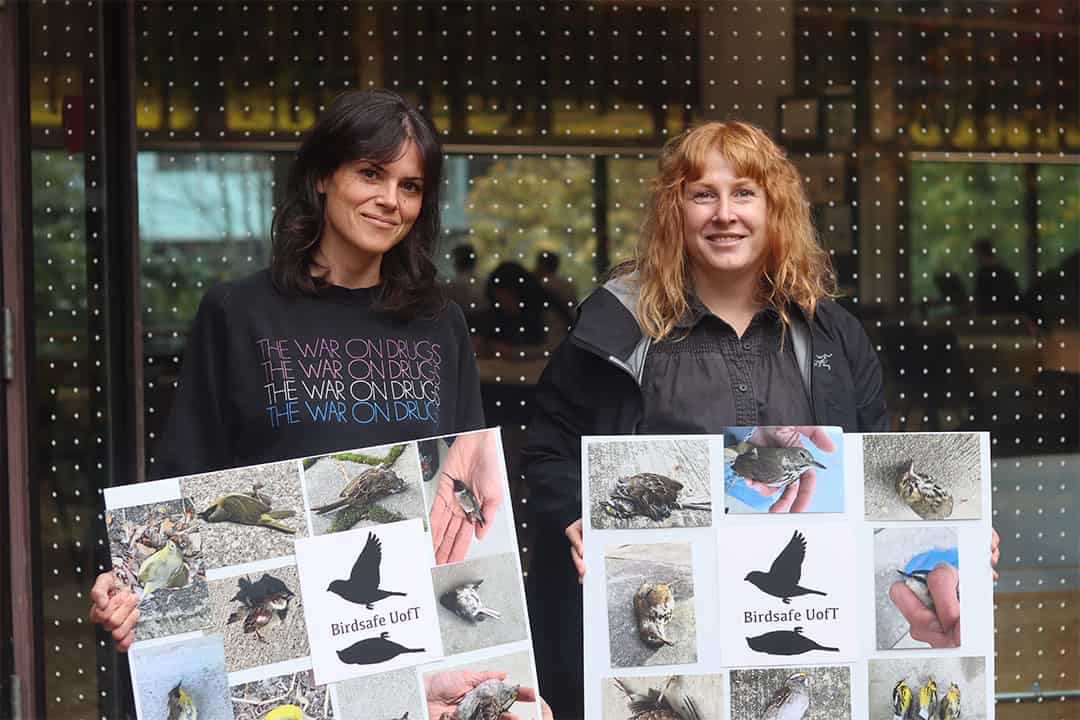Over the course of 21 days in fall 2016, 19 birds from non-native migratory species collided with the windows of U of T Scarborough campus buildings, according to a study conducted by U of T student Omar Yossofzai. The organizers for BirdSafe U of T, an initiative based on the St. George campus, say that bird collisions remain a large issue, and the group has documented over 80 fatal collisions at UTSG since its founding in 2022.
BirdSafe U of T aims to combat this issue. The group has worked with administrators to retrofit some of U of T’s windows to prevent collisions and has recently worked to raise awareness about the issue through a film screening and by posting pictures of birds found on campus. The group also started a petition calling on the university to adopt new bird-safe standards for windows and retrofit old buildings, which has received more than 1,000 signatures as of November 19.
Issue of bird collisions
The Government of Canada has estimated that, in Canada, window collisions cause 16 to 42 million bird deaths, making it a top human-related cause of bird mortality. Birds aid in pest control, pollination, and dispersing seeds, and the Government of Canada’s website notes the importance of protecting birds to maintain healthy ecosystems.
In an interview with Beyond, an online magazine published by the University of British Columbia (UBC) brand and marketing department, Penny Martyn — an architect at UBC who developed bird-friendly guidelines for the campus’ buildings — explained that birds’ eyes focus on moving objects and objects perpendicular to their body instead of straight ahead. Often, birds collide with windows because they see reflections of the landscape, and due to their limited range of speed, they can’t stop in time to avoid crashing once they notice the window.
Birds have a higher chance of colliding with glass near vegetation spaces where they tend to forage. Martyn said that migratory species are most at risk for collisions.
The group’s founding
Carly Davenport — a graduate student studying neurodegenerative diseases at the Institute of Medical Sciences — and Laurna Germscheid, a non-student and artist, created and founded BirdSafe U of T in 2022, after they met while training and volunteering for the Canadian charity Fatal Light Awareness Program (FLAP).
They decided to start an initiative at U of T because they both live near the St. George campus and saw bodies of birds on the ledge of the Edward Johnson Building that they believe died from colliding with the building’s windows.
“I can’t believe, as a graduate of music, that people are practicing music in these [Edward Johnson Building] practice rooms, [while] songbirds are dying here,” said Germscheid.
Addressing the issue
BirdSafe U of T has tried to retrofit windows on buildings at U of T to make them bird-friendly.
In 2022, after graduate student Vanya Georgieva raised her concerns about bird collisions to Chair of Graduate Studies Ettore Damiano and Associate Chair of Graduate Studies Robert MacMillan of the Department of Economics at Max Gluskin House, the team worked with FLAP to use $16,000 from the departmental budgets to retrofit the courtyard of the building with small white markers that follow a grid formation.
Marker patterns that contrast with the window help birds by breaking up the reflection and showing them that a barrier is present. For these dense marking patterns to be effective, they need to leave no gaps more than five centimetres by five centimetres between markers and be outside the surface of the glass according to FLAP.
EJ Pratt Library, located in Victoria College, also treated its windows with high contrast and dense patterns of trees with students’ help. Davenport and Germscheid explain their collaboration with the library began after they cold-emailed the campus about the problem. They said that campus staff such as Kam Jahromi, the interim senior manager of campus operations, seemed very receptive to treating windows. However, they explained that the university’s tree pattern treatments were only temporary due to budget constraints.
Davenport claims they are planning to treat windows for three other buildings and currently working to help the university incorporate these treatments into its budget.
According to U of T News, the Department of Cell and Systems Biology and BirdSafe U of T also worked to retrofit the entrance of the Ramsay Wright Laboratories.
Both founders of BirdSafe U of T told The Varsity that window collisions remain an issue at U of T and need more documentation. Germsheid, Davenport, and other students have documented over 80 birds who fatally collided with buildings like Isabel Bader Theatre, Sidney Smith Hall, the DL Pratt building, the Medical Sciences building, and the Goldring Student Centre. However, Davenport suggested that BirdSafe U of T’s documentation only captures a small part of a more significant issue.
The group currently has a small team of U of T students who inspect windows and report if they see any signs of bird collision. Davenport explains that a patrol of all UTSG buildings can take her two hours, and noted a need for other volunteers.
Due to the organization’s lack of student volunteers available to patrol areas, Davenport suspects that groundskeepers, or predators like squirrels or hawks, sometimes remove birds before the group can document them.
BirdSafe U of T also aims to raise awareness of the issue. The group hosted a movie screening and panel on October 24 for The Messenger, a documentary that investigated how human actions have depleted songbird species’ populations and how this issue can impact the planet.
The group encourages students to connect with them through Instagram to report discoveries of dead birds so it can get data to prioritize which buildings to retrofit.



No comments to display.